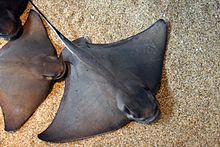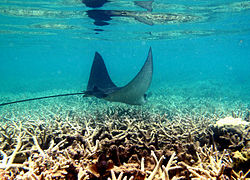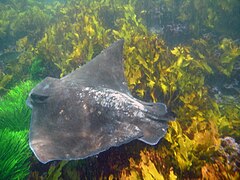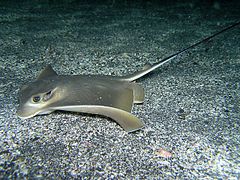Myliobatis
| Myliobatis | |
|---|---|

| |
| Myliobatis californica | |
| Scientific classification | |
| Domain: | Eukaryota |
| Kingdom: | Animalia |
| Phylum: | Chordata |
| Class: | Chondrichthyes |
| Subclass: | Elasmobranchii |
| Order: | Myliobatiformes |
| Family: | Myliobatidae |
| Genus: | Myliobatis Cuvier, 1816 |
| Type species | |
| Myliobatis aquila (Linnaeus, 1758)
| |
| Species | |
|
See text | |
Myliobatis is a genus of eagle rays in the family Myliobatidae.
Description
Myliobatis species can reach a width up to about 1.8 m (6 ft).[2] Their bodies consist of a rhomboidal disc, wider than long, with one dorsal fin. The head is broad and short, with eyes and spiracles on the sides. The tail is slender, with one or two large spines at the base, without tail fin.[3]
The teeth are arranged in the lower and upper jaws in flat tooth plates called pavement teeth, each consisting of about seven series of plates, which are used to crush clam shells and crustaceans.[3]
Biology
Myliobatis species are ovoviviparous. Their gestation lasts about six months, and a female produces four to seven embryos. Myliobatis species mainly feed on molluscs, bottom-living crustaceans, and small fishes.[4]
Habitat
Myliobatis species live in warm, shallow waters. Adults prefer sandy shores, while juveniles can usually be encountered offshore.[3][4]
Species
Extant species
Currently, 11 species in this genus are recognized:[2][5]
| Image | Scientific name | Common Name | Distribution |
|---|---|---|---|
 |
Myliobatis aquila (Linnaeus, 1758) | common eagle ray | Atlantic Ocean (North Sea to South Africa), the Mediterranean Sea and the south-western Indian Ocean. |
 |
Myliobatis australis Macleay, 1981 | Australian bull ray | Eastern Indian Ocean: southern Australia, from Western Australia to Queensland.[6] |
 |
Myliobatis californica T. N. Gill, 1865 | bat eagle ray | eastern Pacific Ocean, between the Oregon coast and the Gulf of California. |
 |
Myliobatis chilensis Philippi {Krumweide}, 1893 | Chilean eagle ray | coasts of Chile and Peru |
 |
Myliobatis freminvillei Lesueur, 1824 | bullnose eagle ray | from Cape Cod down to Argentina |
 |
Myliobatis goodei Garman, 1885 | southern eagle ray | Atlantic coast, from the tip of Florida down to Argentina |
 |
Myliobatis hamlyni J. D. Ogilby, 1911 | purple eagle ray[7] | Australia, Indonesia, the Philippines, Taiwan and Okinawa |
| Myliobatis longirostris Applegate & Fitch, 1964 | snouted eagle ray | Pacific Ocean from Baja California and the Gulf of California to Sechura, Peru | |
| Myliobatis peruvianus Garman, 1913 | Peruvian eagle ray | Pacific Ocean off Chile and Peru. | |
| Myliobatis ridens Ruocco, Lucifora, Díaz de Astarloa, Mabragaña & Delpiani, 2012 | shortnose eagle ray[8] | southwestern Atlantic Ocean off Brazil and Argentina. | |
 |
Myliobatis tenuicaudatus Hector, 1877 | Australian/New Zealand eagle ray | near rocky reefs around New Zealand and southern Australia |
 |
Myliobatis tobijei Bleeker, 1854 | Japanese eagle ray[7] | Indonesia and the Philippines,Japan, Korea, and China. |
Extinct species

Extinct species within this genus include:[9]
- †Myliobatis acutus Agassiz, 1843
- †Myliobatis affinis Chapman & Cudmore, 1924
- †Myliobatis albestii Pauca, 1929
- †Myliobatis altavillae Meschinelli, 1924
- †Myliobatis altus Davis, 1888
- †Myliobatis americanus Bravard, 1884
- †Myliobatis angustidens Sismonda, 1849
- †Myliobatis angustus Agassiz, 1843
- †Myliobatis arcuatus Davis, 1888
- †Myliobatis bellardii Issel, 1877
- †Myliobatis bilobatus Dartevelle & Casier, 1943
- †Myliobatis bisulcus Marsh, 1870
- †Myliobatis bothriodon White, 1926
- †Myliobatis canaliculatus Agassiz, 1843
- †Myliobatis colei Agassiz, 1843
- †Myliobatis crassidens Dartevelle & Casier, 1959
- †Myliobatis dimorphus Delfortrie, 1871
- †Myliobatis dispar Leriche, 1913
- †Myliobatis dixoni Agassiz, 1843
- †Myliobatis elatus Stromer, 1905
- †Myliobatis enormis Mendiola, 1999
- †Myliobatis erctensis Salinas, 1901
- †Myliobatis fastigiatus Leidy, 1876
- †Myliobatis fraasi Stromer, 1905
- †Myliobatis frangens Eastman, 1904
- †Myliobatis funiculatus Delfortrie, 1871
- †Myliobatis gigas Cope, 1867
- †Myliobatis girondicus Pedroni, 1844
- †Myliobatis goniopleurus Agassiz, 1843
- †Myliobatis granulosus Issel, 1877
- †Myliobatis haueri Penecke, 1884
- †Myliobatis holmesii Gibbes, 1849
- †Myliobatis intermedius Dartevelle & Casier, 1943
- †Myliobatis kummeli Fowler, 1911
- †Myliobatis lagaillardei Thomas, 1904
- †Myliobatis lateralis Agassiz, 1843
- †Myliobatis leidyi Hay, 1899
- †Myliobatis leognanensis Delfortrie, 1871
- †Myliobatis lepersonnei Dartevelle & Casier, 1959
- †Myliobatis llopisi Bauzá & Gomez Pallerola, 1982
- †Myliobatis marginalis Agassiz, 1843
- †Myliobatis merriami Jordan & Beal, 1913
- †Myliobatis meyeri Weiler, 1922
- †Myliobatis micropleurus Agassiz, 1843
- †Myliobatis microrhizus Delfortrie, 1871
- †Myliobatis miocenicus Böhm, 1942
- †Myliobatis mokattamensis Stromer, 1905
- †Myliobatis monnieri Cappetta, 1986
- †Myliobatis moorabbinensis Chapman & Pritchard, 1907
- †Myliobatis mordax Leidy, 1876
- †Myliobatis moutai Dartevelle & Casier, 1959
- †Myliobatis nzadinensis Dartevelle & Casier, 1943
- †Myliobatis oweni Agassiz, 1843
- †Myliobatis pachyodon Cope, 1867
- †Myliobatis pachyrhizodus Fowler, 1911
- †Myliobatis pentoni Woodward, 1893
- †Myliobatis placentinus Carraroli, 1897
- †Myliobatis plicatilis Davis, 1888
- †Myliobatis prenticei Chapman & Cudmore, 1924
- †Myliobatis raouxi Arambourg, 1952
- †Myliobatis rima Meyer, 1844
- †Myliobatis rivierei Sauvage, 1878
- †Myliobatis rugosus Leidy, 1855
- †Myliobatis salentinus Botti, 1877
- †Myliobatis semperei Mendiola, 1999
- †Myliobatis sendaicus Hatai, Murata & Masuda, 1965
- †Myliobatis serratus Meyer, 1843
- †Myliobatis sinhaleyus Deraniyagala, 1937
- †Myliobatis stokesii Agassiz, 1843
- †Myliobatis striatus Buckland, 1837
- †Myliobatis strobeli Issel, 1877
- †Myliobatis testae Philippi, 1846
- †Myliobatis tewarii Mishra, 1980
- †Myliobatis toliapicus Agassiz, 1843
- †Myliobatis transversalis Gibbes, 1849
- †Myliobatis tumidens Woodward, 1889
- †Myliobatis undulatus Chaffee, 1939
- †Myliobatis vicomicanus Cope, 1867
- †Myliobatis wurnoensis White, 1934
These eagle rays lived from the Cretaceous to the Quaternary periods (from 70.6 to 0.012 Ma). Fossils of these fishes have been found worldwide.[9]
The extinct species Myliobatis dixoni is known from Tertiary deposits along the Atlantic seaboards of the United States, Brazil, Nigeria, England, and Germany.[9]
Gallery
-
M. aquila
-
M. californica
-
M. freminvillei
-
M. tenuicaudatus
-
M. tobijei
See also
References
- ^ Sepkoski, J. (2002). "A compendium of fossil marine animal genera (Chondrichthyes entry)". Bulletins of American Paleontology. 364: 560. Archived from the original on 2012-05-10.
- ^ a b Froese, Rainer; Pauly, Daniel (eds.). "Species in genus Myliobatis". FishBase. July 2017 version.
- ^ a b c Discover life
- ^ a b World Register of Marine Species
- ^ White, W.T. (2014). "A revised generic arrangement for the eagle ray family Myliobatidae, with definitions for the valid genera". Zootaxa. 3860 (2): 149–166. doi:10.11646/zootaxa.3860.2.3. PMID 25283197.
- ^ "Myliobatis australis | Shark-References".
- ^ a b White, W.T.; Kawauchi, J.; Corrigan, S.; Rochel, E.; Naylor, G.J.P. (2015). "Redescription of the eagle rays Myliobatis hamlyni Ogilby, 1911 and M. tobijei Bleeker, 1854 (Myliobatiformes: Myliobatidae) from the East Indo-West Pacific". Zootaxa. 3948 (3): 521–548. doi:10.11646/zootaxa.3948.3.7. PMID 25947786.
- ^ Ruocco, N.L.; Lucifora, L.O.; de Astarloa, J.M.D.; Mabragaña, E.; Delpiani, S.M. (2012). "Morphology and DNA barcoding reveal a new species of eagle ray from the Southwestern Atlantic: Myliobatis ridens sp. nov. (Chondrichthyes, Myliobatiformes, Myliobatidae)" (PDF). Zoological Studies. 51 (6): 862–873.[permanent dead link]
- ^ a b c Shark References
Further reading
- Aguiar, A.A.; Gallo, V.; Valentin, J.L. (2004). "Using the size independent discriminant analysis to distinguish the species of Myliobatis Cuvier (Batoidea: Myliobatidae) from Brazil". Zootaxa. 464: 1–7. doi:10.11646/zootaxa.464.1.1.
- Compagno, L.J.V. (1999): Checklist of living elasmobranchs. A: Hamlett W.C. (ed.) Sharks, skates, and rays: the biology of elasmobranch fishes., The Johns Hopkins University Press: 471-498.
- Garman, S (1913). "The Plagiostomia (Sharks, Skates and Rays)". Memoirs of the Museum of Comparative Zoology. 36: 1–515.
- Gill, T.N. (1865). "Note on the family of myliobatoids, and on a new species of Aetobatis". Annals of the Lyceum of Natural History of New York. 8: 135–138. doi:10.1111/j.1749-6632.1867.tb00300.x.
- Walker, C. & Ward, D. (1993): - Fossielen: Sesam Natuur Handboeken, Bosch & Keuning, Baarn. ISBN 90-246-4924-2





